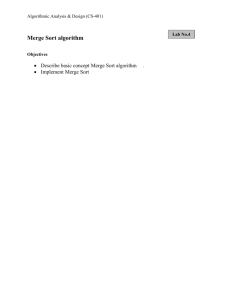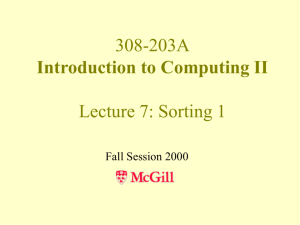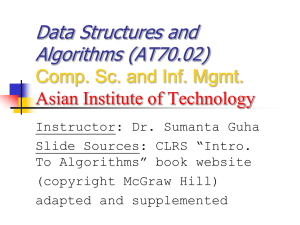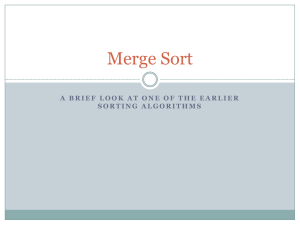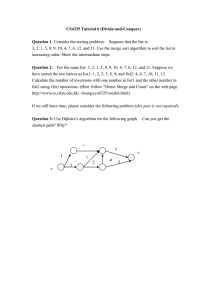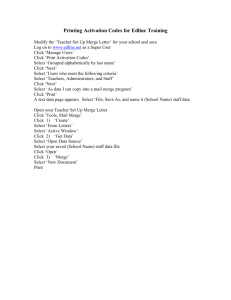Merge Sort and Recurrences COSC 581, Algorithms January 14, 2014
advertisement
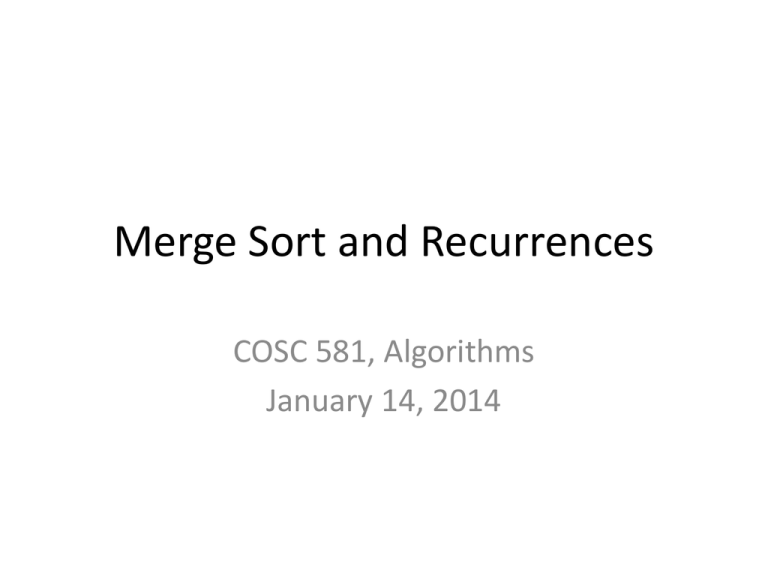
Merge Sort and Recurrences COSC 581, Algorithms January 14, 2014 Reading Assignments • Today’s class: – Chapter 2, 4.0, 4.4 • Reading assignment for next class: – Chapter 4.2, 4.5 3 Common Algorithmic Techniques • Divide and Conquer • Dynamic Programming • Greedy Algorithms Divide and Conquer • Recursive in structure – Divide the problem into sub-problems that are similar to the original but smaller in size – Conquer the sub-problems by solving them recursively. If they are small enough, just solve them in a straightforward manner. – Combine the solutions to create a solution to the original problem An Example: Merge Sort Sorting Problem: Sort a sequence of n elements into non-decreasing order. • Divide: Divide the n-element sequence to be sorted into two subsequences of n/2 elements each • Conquer: Sort the two subsequences recursively using merge sort. • Combine: Merge the two sorted subsequences to produce the sorted answer. Merge Sort – Example Original Sequence 18 26 32 Sorted Sequence 6 43 15 9 1 1 6 9 15 18 26 32 43 18 26 32 6 43 15 9 1 6 18 26 32 1 18 26 32 6 43 15 9 1 18 26 15 43 1 9 18 26 32 6 43 15 9 1 18 26 32 43 15 9 1 18 26 32 6 43 15 9 1 6 32 6 9 15 43 43 Merge-Sort (A, p, r) INPUT: a sequence of n numbers stored in array A OUTPUT: an ordered sequence of n numbers MergeSort (A, p, r) // sort A[p..r] by divide & conquer 1 if p < r 2 then q ← (p+r)/2 3 MergeSort (A, p, q) 4 MergeSort (A, q+1, r) 5 Merge (A, p, q, r) // merges A[p..q] with A[q+1..r] Initial Call: MergeSort(A, 1, n) Procedure Merge Merge(A, p, q, r) 1 n1 ← q – p + 1 2 n2 ← r – q 3 for i ← 1 to n1 4 do L[i] ← A[p + i – 1] 5 for j ← 1 to n2 6 do R[j] ← A[q + j] 7 L[n1+1] ← ∞ 8 R[n2+1] ← ∞ 9 i←1 10 j ← 1 11 for k ←p to r 12 do if L[i] ≤ R[j] 13 then A[k] ← L[i] 14 i←i+1 15 else A[k] ← R[j] 16 j←j+1 Input: Array containing sorted subarrays A[p..q] and A[q+1..r]. Output: Merged sorted subarray in A[p..r]. Sentinels, to avoid having to check if either subarray is fully copied at each step. Merge – Example A … L 6 i 61 86 26 1 32 9 42 43 8 32 9 26 k k k 8 26 32 ∞ i i i i k k R k k … k k 1 9 42 43 ∞ j j j j j Correctness of Merge Merge(A, p, q, r) 1 n1 ← q – p + 1 2 n2 ← r – q 3 for i ← 1 to n1 4 do L[i] ← A[p + i – 1] 5 for j ← 1 to n2 6 do R[j] ← A[q + j] 7 L[n1+1] ← ∞ 8 R[n2+1] ← ∞ 9 i←1 10 j ← 1 11 for k ←p to r 12 do if L[i] ≤ R[j] 13 then A[k] ← L[i] 14 i←i+1 15 else A[k] ← R[j] 16 j←j+1 Loop Invariant for the for loop At the start of each iteration of the for loop: Subarray A[p..k – 1] contains the k – p smallest elements of L and R in sorted order. L[i] and R[j] are the smallest elements of L and R that have not been copied back into A. Initialization: Before the first iteration: •A[p..k – 1] is empty. •i = j = 1. •L[1] and R[1] are the smallest elements of L and R not copied to A. Correctness of Merge Merge(A, p, q, r) 1 n1 ← q – p + 1 2 n2 ← r – q 3 for i ← 1 to n1 4 do L[i] ← A[p + i – 1] 5 for j ← 1 to n2 6 do R[j] ← A[q + j] 7 L[n1+1] ← ∞ 8 R[n2+1] ← ∞ 9 i←1 10 j ← 1 11 for k ←p to r 12 do if L[i] ≤ R[j] 13 then A[k] ← L[i] 14 i←i+1 15 else A[k] ← R[j] 16 j←j+1 Maintenance: Case 1: L[i] ≤ R[j] •By LI, A contains p – k smallest elements of L and R in sorted order. •By LI, L[i] and R[j] are the smallest elements of L and R not yet copied into A. •Line 13 results in A containing p – k + 1 smallest elements (again in sorted order). Incrementing i and k reestablishes the LI for the next iteration. Similarly for L[i] > R[j]. Termination: •On termination, k = r + 1. •By LI, A contains r – p + 1 smallest elements of L and R in sorted order. •L and R together contain r – p + 3 elements. All but the two sentinels have been copied back into A. Analysis of Merge Sort • • • • • Running time T(n) of Merge Sort: Divide: computing the middle takes Θ(1) Conquer: solving 2 subproblems takes 2T(n/2) Combine: merging n elements takes Θ(n) Total: T(n) = Θ(1) if n = 1 T(n) = 2T(n/2) + Θ(n) if n > 1 ⇒ T(n) = Θ(n lg n) (CLRS, Chapter 4) Recurrences • Recurrence is an equation or inequality that describes a function in terms of its value on smaller inputs • Often used to define a recursive algorithm’s runtime • Example: T(n) = 2T(n/2) + n Recurrence Relations • Equation or an inequality that characterizes a function by its values on smaller inputs. • Solution Methods (Chapter 4) – Substitution Method. – Recursion-tree Method. – Master Method. • Recurrence relations arise when we analyze the running time of iterative or recursive algorithms. – Ex: Divide and Conquer. T(n) = Θ(1) T(n) = a T(n/b) + D(n) + C(n) if n ≤ c otherwise Substitution Method • Guess the form of the solution, then use mathematical induction to show it correct. – Substitute guessed answer for the function when the inductive hypothesis is applied to smaller values – hence, the name. • Works well when the solution is easy to guess. • No general way to guess the correct solution. Example 1 – Exact Function Recurrence: T(n) = 1 T(n) = 2T(n/2) + n Guess: T(n) = n lg n + n. Induction: if n = 1 if n > 1 •Basis: n = 1 ⇒ n lgn + n = 1 = T(n). •Hypothesis: T(k) = k lg k + k for all k < n. •Inductive Step: T(n) = 2 T(n/2) + n = 2 ((n/2)lg(n/2) + (n/2)) + n = n (lg(n/2)) + 2n = n lg n – n + 2n = n lg n + n Recursion-tree Method • Making a good guess is sometimes difficult with the substitution method. • Use recursion trees to devise good guesses. • Recursion Trees – Show successive expansions of recurrences using trees. – Keep track of the time spent on the subproblems of a divide and conquer algorithm. – Help organize the algebraic bookkeeping necessary to solve a recurrence. Recursion Tree – Example • Running time of Merge Sort: T(n) = Θ(1) T(n) = 2T(n/2) + Θ(n) • Rewrite the recurrence as if n = 1 if n > 1 T(n) = c if n = 1 T(n) = 2T(n/2) + cn if n > 1 c > 0: Running time for the base case and time per array element for the divide and combine steps. Recursion Tree for Merge Sort For the original problem, we have a cost of cn, plus two subproblems each of size (n/2) and running time T(n/2). cn Each of the size n/2 problems has a cost of cn/2 plus two subproblems, each costing T(n/4). cn Cost of divide and merge. cn/2 T(n/2) cn/2 T(n/2) T(n/4) T(n/4) T(n/4) T(n/4) Cost of sorting subproblems. Recursion Tree for Merge Sort Continue expanding until the problem size reduces to 1. cn cn/2 cn/2 cn cn lg n cn/4 c c cn/4 cn/4 c cn/4 cn c c c cn : cnlgn+cn Total Recursion Tree for Merge Sort Continue expanding until the problem size reduces to 1. cn • Each level has total cost cn. • Each time we go down one level, the number of subproblems doubles, but the cost per cn/2 cn/2 subproblem halves ⇒ cost per level remains the same. • There are lg n + 1 levels, height is cn/4 cn/4 cn/4 cn/4 lg n. (Assuming n is a power of 2.) • Can be proved by induction. • Total cost = sum of costs at each level = (lg n + 1)cn = cnlgn + cn = c c c c c c Θ(n lgn). Recursion Trees – Caution Note • Recursion trees only generate guesses. – Verify guesses using substitution method. • A small amount of “sloppiness” can be tolerated. Why? • If careful when drawing out a recursion tree and summing the costs, can be used as direct proof. Summing up Cost of Recursion Trees • Evaluate: – Cost of individual node at depth i – Number of nodes at depth i – Total height of tree Recursion Tree for Merge Sort Continue expanding until the problem size reduces to 1. 𝑐𝑐 cn • Cost of node at depth i = 2𝑖 cn/2 cn/4 cn/2 cn/4 cn/4 cn/4 • Number of nodes at depth i = 2𝑖 • Depth of tree = # times can divide cn by 2𝑖 until we get value of 1 = lg 𝑛 + 1 • Putting together: lg 𝑛+1 c c c c c c � 𝑖=0 2𝑖 lg 𝑛+1 𝑐𝑐 = � 𝑐𝑐 𝑖 2 𝑖=0 = Θ(𝑛 lg 𝑛) Can also write out algebraically… 𝑛 𝑇 𝑛 = 𝑐𝑐 + 2𝑇 2 = 𝑐𝑐 + 2 𝑐𝑐/2 + 2𝑇 𝑛 4 = 𝑐𝑐 + 2𝑐𝑐/2 + 2 2𝑐𝑐/4 + 2𝑇 =… lg 𝑛+1 𝑖 𝑐𝑐 2 𝑖 2 = ∑𝑖=0 = Θ(𝑛 lg 𝑛) lg 𝑛+1 = ∑𝑖=0 𝑐𝑐 𝑛 8 Example 2 • Formulate (and solve) recursion tree for: 𝑇 𝑛 = 2𝑇 𝑛 − 1 + 𝑐 Example #3 • Insertion sort can be expressed as a recursive procedure as follows: – In order to sort A[1..n], we recursively sort A[1.. n–1] and then insert A[n] into the sorted array A[1..n–1]. Write a recurrence for the running time of this recursive version of insertion sort. Example #4 • Argue that the solution to the recurrence: 𝑛 2𝑛 𝑇 𝑛 =𝑇 +𝑇 + 𝑐𝑐 3 3 where c is constant, is Ω(𝑛 lg 𝑛) by appealing to a recursion tree. Recall 3 Methods for Solving Recurrence Relations • Solution Methods (Chapter 4) – Substitution Method – Recursion-tree Method – Master Method -- Today -- Today -- Next time Next Time: The Master Method • Based on the Master theorem. • “Cookbook” approach for solving recurrences of the form T(n) = aT(n/b) + f(n) • a ≥ 1, b > 1 are constants. • f(n) is asymptotically positive. • n/b may not be an integer, but we ignore floors and ceilings. Why? • Requires memorization of three cases. Reading Assignments • Reading assignment for next class: – Chapter 4.2, 4.5
